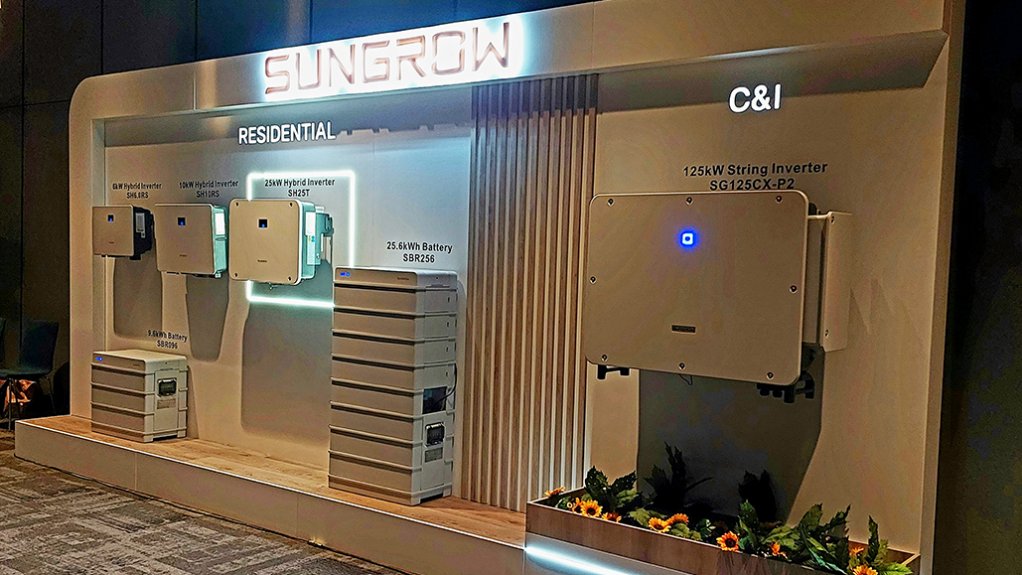Solar power solutions company Sungrow has unveiled its three-phase inverter and battery energy solution in South Africa, featuring several new inverter models and battery options suited for both residential and commercial or industrial applications.
For residential applications, the single phase inverters include a 6 kW and 10 kW option, while the new three phase inverters include a 15 kW, 20 kW and 25 kW option. For commercial and industrial applications, the company now also offers a 125 kWh string inverter.
Each of these can be paired with specialised 9.5 kWh or 25.6 kWh batteries and hooked up to a solar photovoltaic (PV) array.
“Last year, we were mainly focused on launching our single-phase inverter that was mainly dedicated to residential households. But now we’re seeing that the attention and focus in South Africa is moving towards low commercial and industrial applications, and for those kinds of loads, we typically require a three-phase hybrid inverter,” Sungrow Middle East and Africa channel business director Ezzat Sankari told Engineering News at the launch event, in Johannesburg, on March 15.
The three-phase battery and inverter system was designed to be a more powerful solution to enable large homes and small- to medium-sized businesses run more energy-intensive appliances and equipment without interruption.
"This is the latest development that has been brought to South Africa upon verifying and studying the requirements that we saw in South Africa along with some other markets that share the same specifics and particulars of the country,” Sankari said.
Sungrow engineer Leonard Visser explained that the estimated return on investment of these systems was three years, after which the savings accrued from lower grid power use would start to yield a profit.
The system features three maximum power point trackers for different orientations operating between 150 V and 950 V, thereby optimising roof space and extending working hours.
Moreover, he explained that the system’s all-panel compatibility would ensure maximum energy use at improved efficiency.
“The system deploys high voltage lithium ferro phosphate, which by nature of the circuit architecture makes the losses internally inside the inverter much less and the cable cross sections that you require outside the inverter and in connection between the batteries. The inverters are even smaller in size, which also makes the system more efficient and experience less losses,” Sankari explained.
Visser added that it was possible to string together up to eight inverters with 32 batteries.
“You can run a single unit connected to alternating current (ac) load or you can parallel these units for up to eight units, providing up to 200 kW total capacity,” he explained.
The system features an arc-fault circuit interrupter which reacts in 200 ms over a distance of 200 m, thereby ensuring safety.
This system will detect any arc faults within the PV string array and it will isolate the area immediately, Visser explained.
He emphasised that the speciality of the Sungrow system lay in the patented Potential Induced Degradation (PID) Zero technology, which had been incorporated into the product.
He explained that this technology was essential because long exposure to high temperature, high humidity, and too much dust led to unavoidable PID in PV modules. He pointed out that permanent PID can lead to a power generation loss of up to 30%.
“We all know that solar panels degrade over time. That’s why we have a function called PID Zero design, which sends a negative feed to your two panels during the night, restoring them from degradation,” he explained.
The system accounts for a 10 ms changeover time when the grid fails.
“This is doable through our capability on the AC output of the system. It allows for between a 15 kW and a 200 kW backup hybrid solution. With that being said, you can start your battery capacity from 25.6 kWh up until 890.2 kWh,” Visser explained.
He added that the system featured a 100% depth of discharge (DOD) capability up to 6 000 cycles. He claimed that Sungrow competitors could only offer an 80% DOD capability up until 4 000 cycles.
In addition, Visser pointed out that Sungrow’s products were linked to the company’s iSolar cloud app, which helped users monitor and optimise their solar energy use, increasing consumption transparency by providing 10 second data refresh rates on power consumption in real time.
As many as 40% of Sungrow’s employees work in research and development, as the company seeks to continue developing this kind of technology to improve efficiencies and widen applications.
“We are currently focusing on developing solar inverters and energy storage using hydrogen as well. Electric vehicle charging infrastructure is also coming in. We hope to see that in South Africa at some point, and also a handful of other sustainability and renewable energy products,” Sankari said.
Edited by: Chanel de Bruyn
Creamer Media Senior Deputy Editor Online
EMAIL THIS ARTICLE SAVE THIS ARTICLE
ARTICLE ENQUIRY
To subscribe email subscriptions@creamermedia.co.za or click here
To advertise email advertising@creamermedia.co.za or click here













